Author: Lars Kabel
Puerto Ayora, 1977
Gus Angermeyer ran a backpacker hotel in the town. The place consisted of two small houses with a couple of rooms, two gas burners, a tap, a toilet, and a cement shed in the garden where we slept on the floor. Gus received us, stocky, longhaired, burned brown from the sun, dressed only in a pair of cut-off shorts. An amiable man of around 60. We, three young Danish women and I, hoped there was room for all of us there. There were just two others, one, son of a diplomat, and hippie, had been on Galapagos for a long time and was a true animal lover. He fed the mice in the house and instructed us that we must never kill geckos and the enormous spiders that crawled around under the ceiling – they ate the harmful insects. The other was a German biology student.
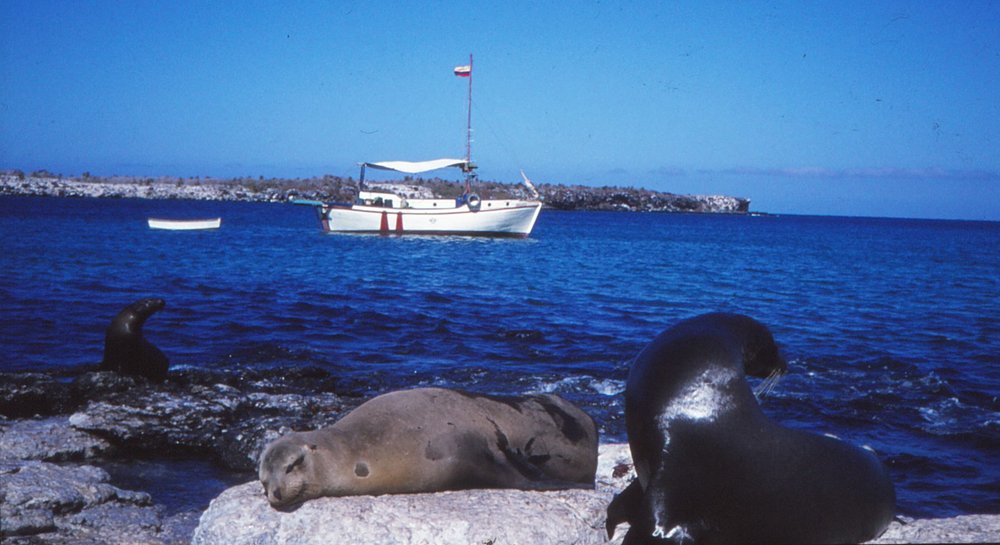
It turned out that Gus’ house, shed, and garden, was the place in Puerto Ayora where backpackers met. We all used the same new guidebook, both to find places of interest that hadn’t been destroyed by “mass tourism” as we said then, and to meet like-minded who saw themselves as part of a Western youth culture that travelled authentically, cheaply, and at eye-level with the locals.
We agreed with Gus that we could stay there for 10 days, broken by a sailing tour of the island domain. The tour he could easily arrange. He fixed us up with permission, and had, at his disposal, a boat, Encentada, with captain, guide and cook. Gus told us that for the locals there was more money in hiring temporarily modified fishing boats to tourists than in coast fishing. They could always catch fish in their dinghies.
The four days in the fishing boat where we slept on deck because the boat was crawling with cockroaches, was an experience for life.
We knew little about the Galapagos when we travelled there. That was the norm then, before the whole world was displayed on the web and on mobiles, in colour photos and videos.
Already, the sight of the Itabaca Channel was unique – we from the cold and winter grey North, had never seen anything like it. The channel was luminous turquoise, emerald green, and ultramarine – cactus crowned the slopes, pelicans fished, on lava at the water’s edge lay a group of seals, lazing in the sun, their coats glistening. A couple of small boats commuted back and forth across the narrow channel that was absolutely not bounty beautiful with palms but was nevertheless just what we had dreamed of.
The village, Puerto Ayora consisted mainly of gravel roads, and a few small hotels and shops by the square and a gravel road out to the research station which did not looked like much. By the mole out in Academy Bay lay dinghies tied up. Out in the bay, at anchor, floated a handful of fishing boats, a couple of deep-water yachts, and two small cruise ships. Everything was warm, calm, and sedate, even though tourists had begun to arrive in the islands, especially however to the cruise ships.
Back from the trip, Gus invited us to visit him in his ’cave’ by the family house at Angermeyer Point. Built of cement and lava blocks he himself had retrieved from the dry bush by the sea. From outside, the ´cave´ did not look out of much either, but it did inside. A little light came down from the ceiling, but otherwise it was lit by petroleum lamps and candles. On the floor lay goatskins on which you could sit softly and well. Everywhere there were bits of weathered flotsam, the jaws of sharks with rows of sharp teeth, and dried spiky boxfish. There were skulls from dead sealions and goats. Dark red and black coral. Conches and beach shells of all sizes, and multi-coloured mother of pearl. Curved tusks from wild pigs. There was also a model ship of a galleass in wood, named Santa Maria, in which Gus and his four brothers had fled Nazi Germany at the end of the 1930s.
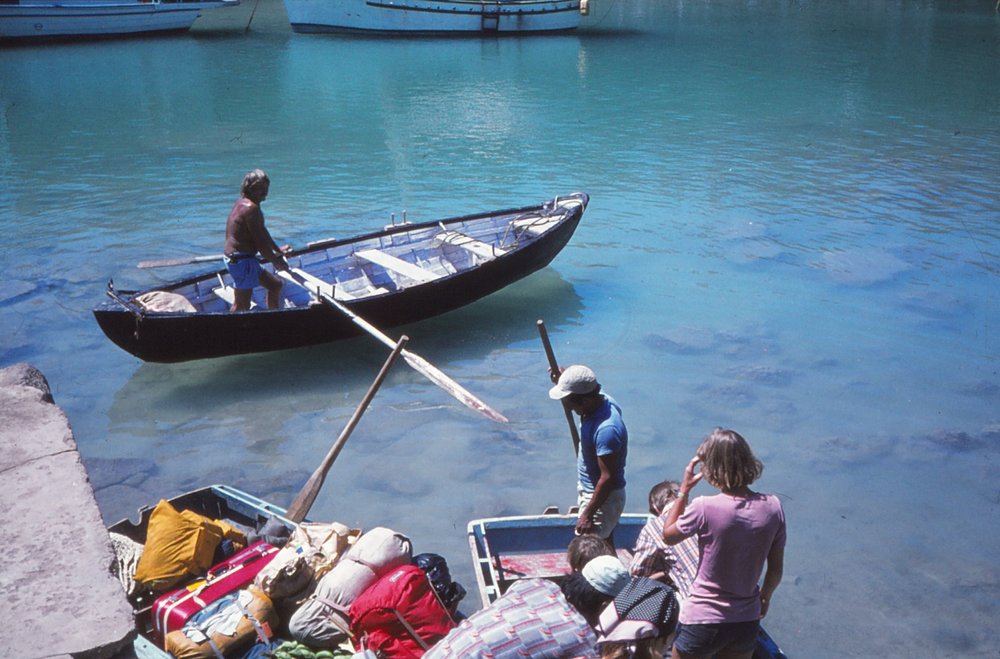
On Santa Cruz, Gus was called: ”King of Galapagos”. He had managed to make the hard existence of a settler a success. Gus sat on a large block of lava at the bottom of the ’cave’ surrounded by goatskins. Behind him a portal of whale ribs had been erected that was almost a throne. The King was holding court. We sat on the floor and drank in the atmosphere. Physically he was in excellent shape, but little by little had become an elderly man that clearly wished to impress his young guests with fantastic stories from 40 years on the islands – in particular, the young Nordic women.
At the Research Station, 1993
We trudged from the hotel in Puerto Ayora by a rocky path out to the station. Leading the way was the botanist, Henning Adsersen from Copenhagen University. Together, in 1993, we had put together a further education course for 11 environmental journalists from news media in Denmark, Norway, Finland, and Greenland. The aim was to increase the knowledge of the media about the Galapagos, and in the light of the UN’s environmental conference in Rio in 1992, to illustrate the significant principal issues connected to environmental protection in the island group to the benefit of nature, the population, and the tourists of which there were around 60,000 annually at that time. Was the Galapagos effort a universal model for sustainable stewardship of nature around the world?
Henning Adsersen and I did not have an appointment. We had tried to contact the personnel at the station. We had rung and written – this was before e-mail – but had not got through. We went in a bunch up towards the administration. The director, Chantal Blanton, came out. She looked at us with a strange look on her face, obviously totally ignorant of the arrival of 13 people. Seconds passed, then her expression changed. Recognizing Henning, a large smile spread across her face, and she gave him a warm handshake and bade us welcome. This was the start of two days VIP treatment. A meeting room was placed at our disposal and the director, and four researchers, gave us presentations.
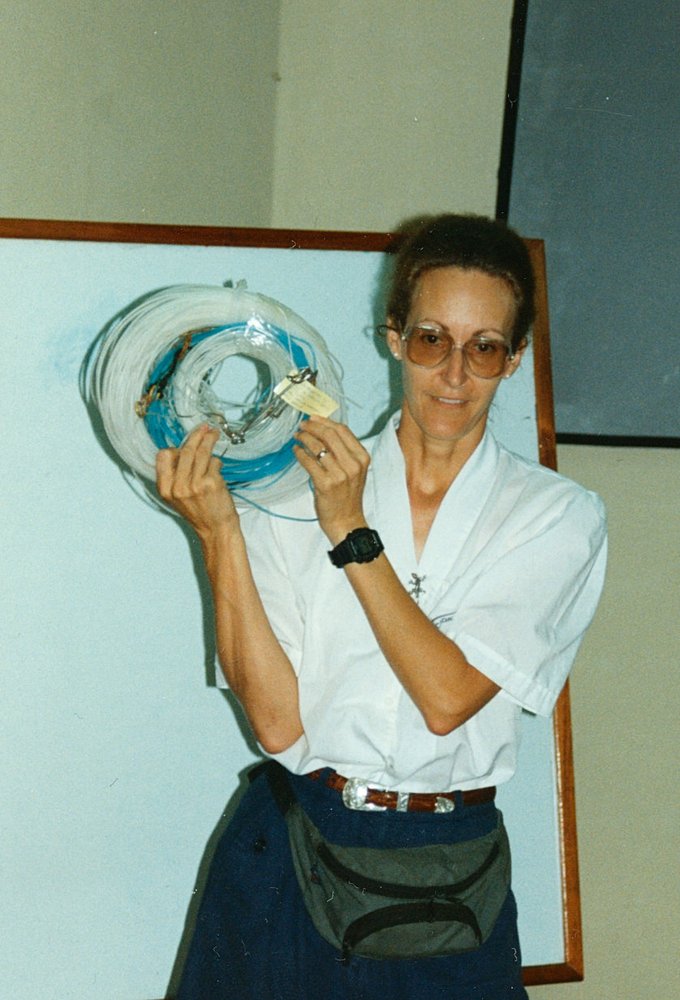
The background to this hospitality was the fact that Henning, over six stays since 1974, had lived and researched at the station for a total of 2½ years. He had done this in collaboration with Professor Ole Hamann from Copenhagen University who worked at the station in 1971 and had later stayed on the islands many times. Ole Hamman was also vice-president of the Charles Darwin Foundation from 1984-1997.
As scientists, both saw a clear interest in an increased focus on a deeper understanding of the Galapagos in the Nordic news media.
Over two days, botanists Henning Adsersen and Hugo Valdebenito, marine biologists Godfrey Merlen and Pat Wheelan, Linda Cayot, who was responsible for the station’s turtle programme, and Chantal Blanton, herself a Ph.D. botanist, provided us with a current picture of the Galapagos, biologically and socially:
They told us that the populations of land iguanas, sea iguanas, and endemic birds was in a fairly good state. The same was true for the tortoise population. The introduction of soil containing seed, and chinchona trees, was a challenge. The trees could not be felled as they were the national tree of Ecuador, but they weakened the native vegetation.
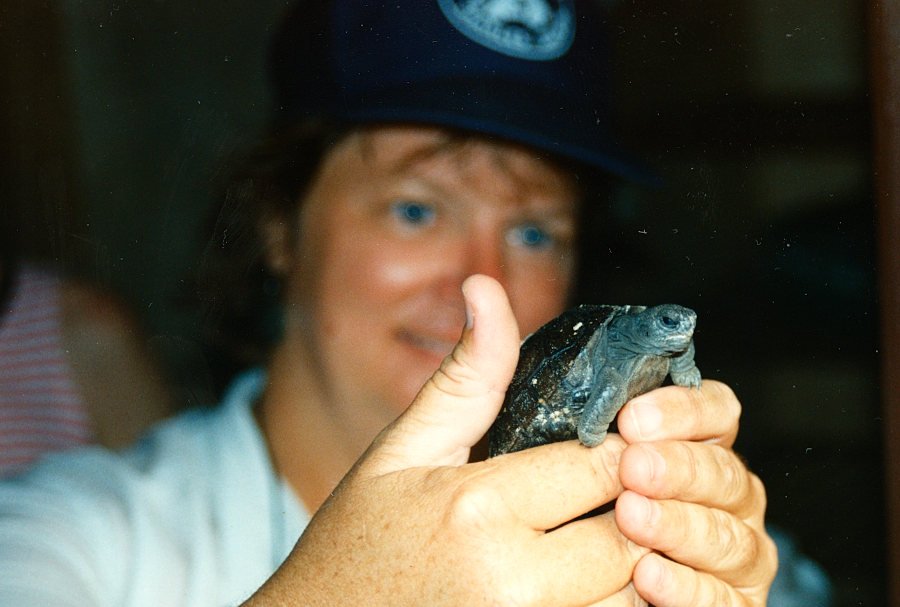
A comprehensive collection and export of the sea cucumber, Papino del Mar, to China and Japan was a major problem. Pat Wheelan handed Henning and I some black and white photos that documented that fishermen had set up camp on Fernandina and were drying Papino del Mar. He hoped we could get the Nordic news media to write critically on overfishing, but we couldn’t. At that time, there was no interest in the media for such subjects. It was difficult to understand the importance of the sea cucumber for the eco-system.
According to the researchers, the culling of the approximately 100,000 goats living wild on the islands was going according to the programme. The goats were also being shot from helicopters. On two of the smaller islands the goats had been successfully eradicated and the researchers were eager to see how long it would take before nature was re-established.
The overall message was along the line that things were actually going fairly well in protecting nature and clearing the national park of invasive species, but the researchers complained that the local population didn’t understand how unique and valuable their nature was. Also at that time, the Galapagos was the setting for a hard social conflict around land, nature’s resources, and conservation for posterity. There was a need to provide an inclusive information and educational effort to the local population.
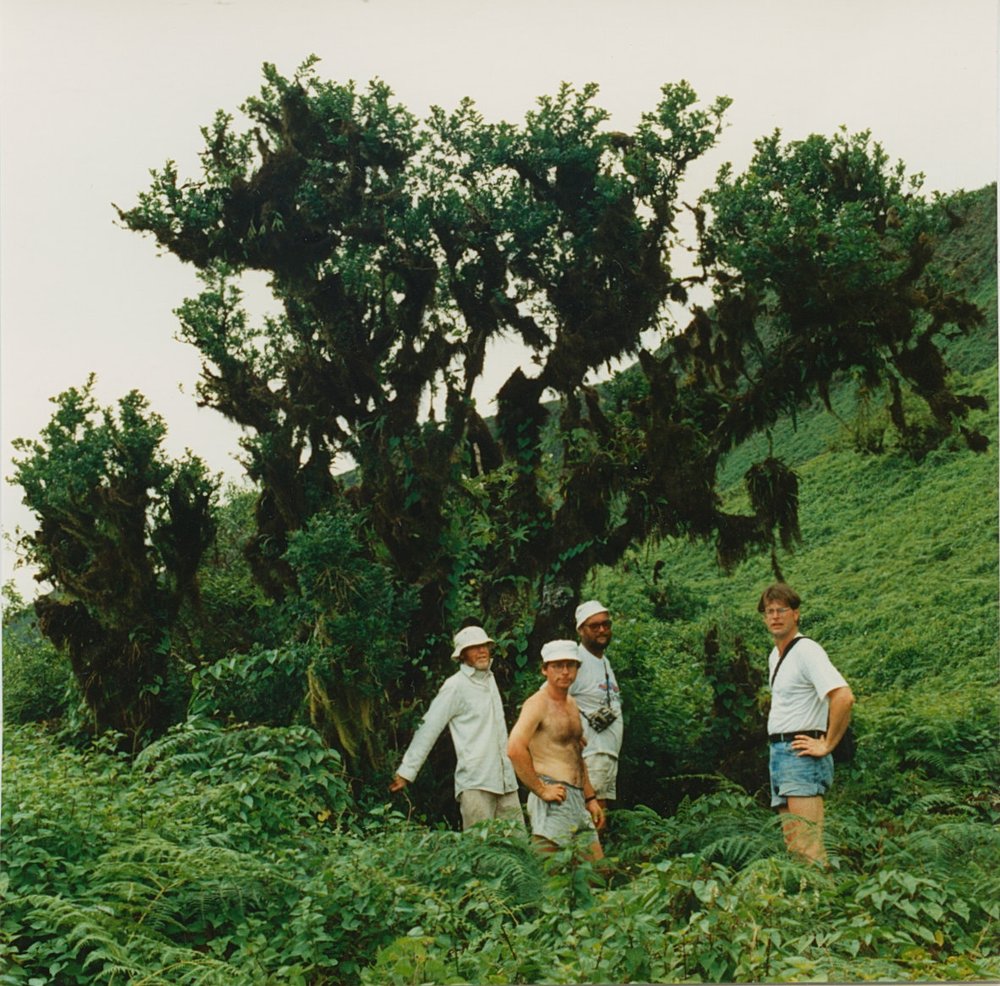
Back in Puerto Ayora, we were met by a lovely sight; a newly arrived white cruise ship lay at anchor in Academy Bay. We embarked on M/S Coral for a seven-day foray with Henning Adsersen as our nature guide. We had been given permission from the national park for 17 disembarkations on eight islands. The input from the researchers at the station had laid a solid foundation under everything Henning showed and explained to us.
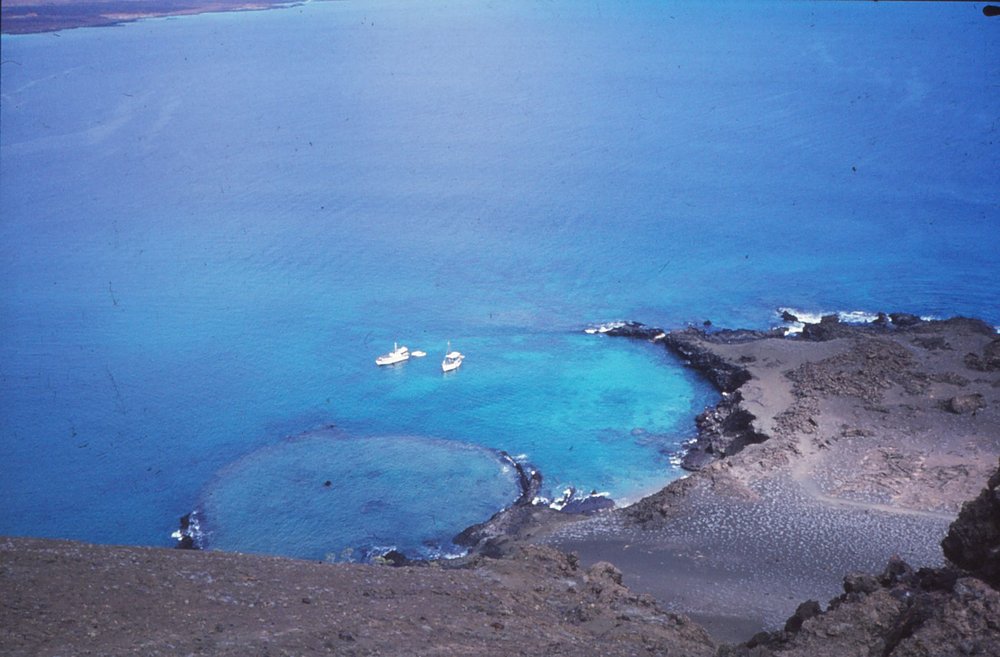
And yes, in the Galapagos, in 1993, we glimpsed the contours of a universal model for the contemporary protection and sustainable utilisation of nature.
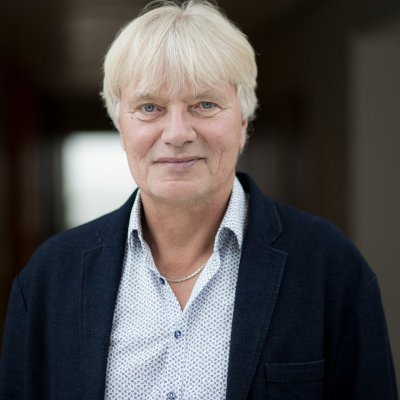
About the author:
Lars Kabel, 1953. Ass. Professor at The Danish School of Media and Journalism, affiliated the department of Research & Development. Journalists and M.A. from the University of Aarhus. Lifelong commitment to nature, environment, climate change and environment journalism. Author and co-author to several textbooks about media ecology, journalism, digital transformation, international news, third world development. Have visited Galapagos and the research station in 1977, 1993 and 2022.





